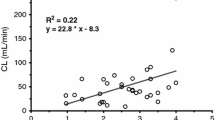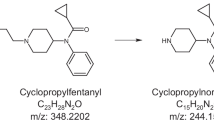Summary
Fentanyl, a short-term analgesic frequently used in neuroleptanalgesia, has in a number of cases been reported to cause unexpected, severe postanesthetic respiratory depression which can successfully be treated with naloxone. Several explanations for this rebound effect produced by fentanyl (in combination with other drugs) have been proposed, though so far none has proved completely satisfactory.
The possibility that this effect may be due to a secondary accumulation of fentanyl or fentanyl metabolites with opioid activity in the brain has led us to investigate the relative opioid potency of several known or proposed metabolites by measuring their inhibitory action on the contraction of guinea-pig ileum in comparison with that of morphine, pethidine, and fentanyl itself. Two proposed metabolites containing the phenethyl sidechain were found to possess an opioid activity lying between that of morphine and pethidine, whereas metabolites without the side-chain were generally less active than pethidine. Using thin-layer chromatography, it was possible to detect one of these proposed active metabolites in vivo in rats. This result may have some relevance for the understanding of the fentanyl rebound. However, the possibility that multiple doses of fentanyl, such as may be given during neuroleptanalgesia, or interactions with other drugs, e.g. tranquilizers and general anesthetics, may be the cause of fentanyl robound, remains open.
Similar content being viewed by others
References
Adams AP, Pybus DA (1978) Delayed respiratory depression after use of fentanyl during anaesthesia. Br Med J 1:278–279
Becker CD, Paulson BA, Miller RD, Severinghaus JW, Eger EI (1976) Biphasic respiratory depression after fentanyl-droperidol or fentanyl alone used to supplement nitrous oxide anesthesia. Anesthesiology 44:291–296
Casy AF, Hassan MMA, Simmonds AB, Staniforth D (1969) Structure-activity relations in analgesics based on 4-anilinopiperidine. J Pharm Pharmacol 21:434–440
Clouet HD (1962) The methylation of normorphine in rat brain and liver. Life Sciences 1:31–34
Frincke JH, Henderson GL (1980) The major metabolite of fentanyl in the horse. Drug Metab Dispos 8:425–427
Goodman LL, Pasternak GW (1984) Multiple opiate receptors. In: Pasternak GW (ed) Analgesics: Neurochemical, behavioral and clinical perspectives. Raven Press, New York, pp 69–96
Goromaru T, Furuta T, Baba S, Yoshimura N, Miyawaki T, Miyao J (1981) Metabolism of fentanyl in rats and man. Anesthesiology 55:A 173
Hess R, Herz A, Friedel K (1971) Pharmacobinetics of fentanyl in view of the importance for limiting the effect. J Pharmacol Exp Ther 179:474–484
Heykants J (1977) On the pharmacokinetics of fentanyl. Interner Bericht Janssen Pharmaceutica, Beerse
Hug CC, Murphy MR (1979) Fentanyl disposition in cerebrospinal fluid and plasma and its relationship to ventilatory depression in the dog. Anesthesiology 50:342–349
Hug CC, Murphy MR (1981) Tissue redistribution of fentanyl and termination of its effects in rats. Anesthesiology 55:369–375
Jacobson AE, Klee WA, Dunn WJ (1977) A quantitative relationship between antinociceptive opiate receptor affinity and lipohilicity. Eur J Med Chem 12:49–52
Janssen APJ, Eddy NB (1960) Compounds related to pethidine. IV. New general chemical methods of increasing the analgesic activity of pethidine. J Med Pharm Chem 2:31–45
Janssen APJ, Niemegeers CJE, Dony JGH (1963) The inhibitory effect of fentanyl and other morphine-like analgesics on the warm water induced tail withdrawal reflex in rats. Arzneimittel-Forschung 13:502–507
Janssen APJ, Gardocky JF (1964) US patent 3, 141, 823 (Cl. 167-65 July 21, Appl. Sept. 4, 1962, 4 pp (ref. CA 61: P 10 689b)
Kamp H-D (1982) Opioidrebound and Antagonisierung. Aufwachphase, Aufwachtraum. In: Ahnefeld EW (ed) Klinische Anästhesiologie und Intensivtherapie, Bd 24. Springer, Berlin Heidelberg
Kosterlitz HW, Watt AJ (1968) Kinetic parameters of narcotic agonists and antagonists, with particular reference to naloxone. Br J Pharmac Chemother 33:266–276
Lehmann KA, Möseler G, Daub D (1981) Biotransformation von Fentanyl. I. In-vitro Abbau durch Gewebe der Maus. Anaesthesist 30:461–466
Lehmann KA, Weski C, Hunger L, Heinrich C, Daub D (1982) Biotransformation von Fentanyl. II. Akute Arzneimittel-interaktionen — Untersuchungen bei Ratte und Mensch. Anaesthesist 31:221–227
Lehmann KA, Hunger L, Brandt K, Daub D (1983) Biotransformation von Fentanyl. III. Einflüsse chronischer Arzneimittelexposition auf Verteilung, Metabolismus und Ausscheidung bei der Ratte. Anaesthesist. 32:165–173
Leysen J, Gommeren W, Laduron P (Discrimination of narcotic drugs on 3H-fentanyl receptor binding. Arch Int Pharmacodyn 220:335–338
Lobbezoo MW, Soudijin W, Wijngaarden I (1980) Structure and receptor interactions of morphinomimetics. Part 1: Hydroxy and methoxy derivatives of fentanyl and some morphine analogues. Eur J Med Chem 15:357–361
McClain DA, Hug CC (1980) Intravenous fentanyl kinetics. Clin Pharmacol Therap 28:106–114
Perry WLM (1970) In: Perry WLM (ed) Pharmacological experiments on isolated preparations. Livingstone, Edinburg
Pert CB, Snyder SH (1973) Opiate receptors: Demonstration in nervous tissue. Science 179:1011–1014
Portoghese PS, Alreja BD, Larson DL (1981) Allylprodine analogues as receptor probes. Evidence that phenolic and nonphenolic ligands interact with different subsites on identical opioid receptors. J Med Chem 25:782–787
Schulz R, Wüster M, Rubini P, Herz A (1981) Functional opiate receptors on the guinea-pig ileum. J Pharmacol Exp Ther 23:547–550
Soudijn W (1978) The pharmacology and the pharmacolinetics of fentanyl. In: Wood C (ed) Stress-free anaesthesia, London. The Royal Society of Medicine and Academic Press, London, p 3
Stahl KD, Bever W van, Janssen P, Simon EJ (1977) Receptor affinity and pharmacological potency of a series of narcotic analgesics. Eur J Pharmacol 46:199–205
Stoeckel H, Hengstmann JH, Schüttler J (1979) Pharmacokinetics of fentanyl as a possible explanation for recurrence of respiratory depression. Br J Anaesth 51:741–744
Wenquia J et al. (1981). Studies on synthesis and relationship between analgesic activity and receptor affinity for 3-methyl fentanyl derivatives. Scientia sinica 24:710–720
Wüster M, Schulz R, Herz A (1981) Multiple opiate receptors in peripheral tissue preparations. Biochem Pharmacol 30:1883–1887
Author information
Authors and Affiliations
Rights and permissions
About this article
Cite this article
Schneider, E., Brune, K. Opioid activity and distribution of fentanyl metabolites. Naunyn-Schmiedeberg's Arch. Pharmacol. 334, 267–274 (1986). https://doi.org/10.1007/BF00508781
Received:
Accepted:
Issue Date:
DOI: https://doi.org/10.1007/BF00508781




